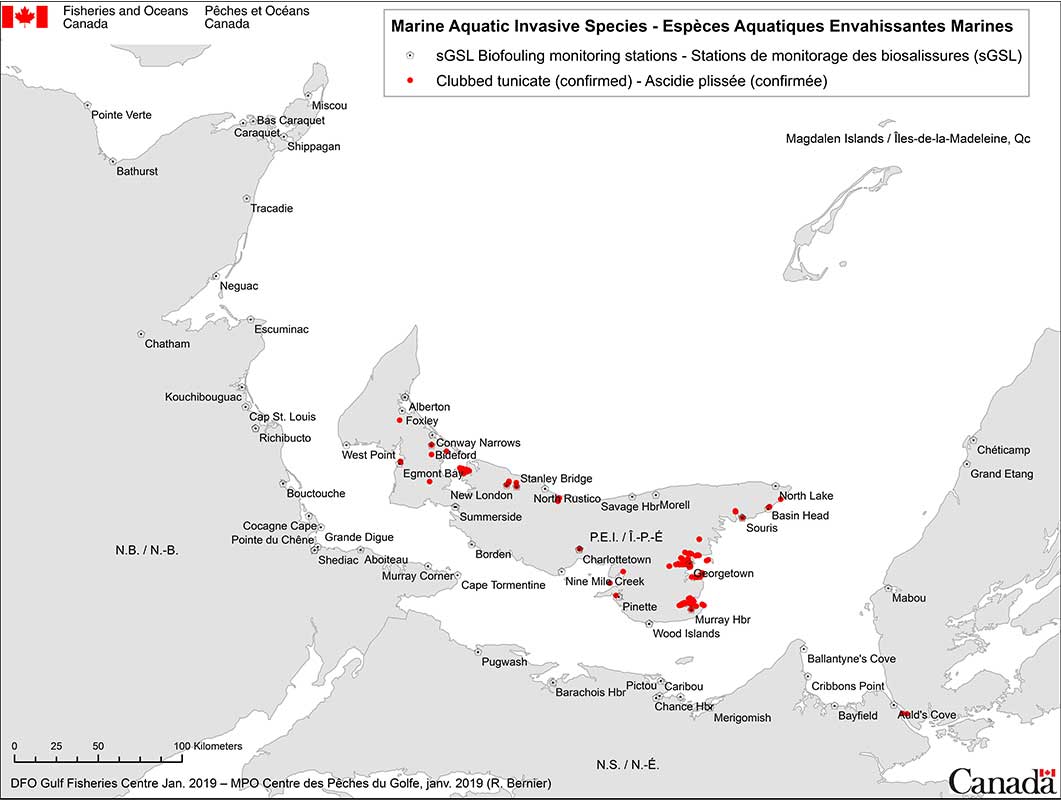Clubbed Tunicate
Styela clava
Report it
If you think you have found an aquatic invasive species:
- do not return the species to the water
- take photos
- note:
- the exact location (GPS coordinates)
- the observation date
- identifying features
- contact us to report it
Identifying features
- Body firm and wrinkled with little bumps, shaped like a water-filled wineskin. Presence of a solid stalk. Leathery texture;
- Measures up to 18 cm, the stalk accounting for one third of its length;
- Colour brown;
- Solitary, but may grow in very dense clumps.
Similar species (native)
Among native species, sea potatoes and sea peaches are other tunicates, but they are solitary or found in small groups. The sea potato is shaped like a rattle and has a stalk that can reach 13 cm. The sea peach's body is firm and rounded and its skin is rough.
Stalked Tunicate (Styela montereyensis)
On the west coast, Clubbed Tunicate can be confused with Stalked Tunicate but the latter can be distinguished by its regular longitudinal grooves and one recurved siphon.
Where it has been found
Has been present in Pacific Canadian waters since at least 1994 when specimens were collected at Nanaimo, Vancouver Island. In British-Columbia, this species has been reported from the Strait of Georgia, specifically: Nanaimo, French Creek Marina, Nanoose Bay, Maple Bay, Baynes Sound, Okeover Inlet, Cortes Island, West Redonda, Quadra Island, Deep Bay Marina and the wharf at the Institute for Ocean Sciences in Sidney.
In Atlantic Canada, Clubbed Tunicate has been reported in the Gulf of St. Lawrence since 1997 and has generally remained restricted to waters surrounding Prince Edward Island (PEI). Since 2012, the clubbed tunicate has been confirmed from Lunenburg, Bedford Basin, and Chedabucto Bay on the southern shore of Nova Scotia
Habitat
Clubbed Tunicate typically occurs between 15-25m depth but has already been recorded at 40m. When located in some microhabitats (e.g., under rocks) or sheltered habitats with low wave action (eg., inlets, bays, harbours and marinas), Clubbed Tunicate can resist tidal immersion. This species can be found attached to a range of artificial substrates, including pier pilings, jetty walls, concrete structures, submerged ropes, buoys, floating docks, and vessel hulls.
Ecological and economic impacts
This species’ ability to settle on a range of artificial surfaces causes dense fouling of fishing gear, moorings, and ropes and is difficult and time-consuming to remove. In Prince Edward Island, mussel lines and floating docks have been weighed down by heavy growth of Clubbed Tunicate, making them difficult to remove from the water. The tremendous density and abundance of this species in PEI is considered a serious threat to the long-term economic viability of the shellfish industry.
Origins and mode of arrival
Native of Western Pacific Ocean.
East coast
It is believed that Clubbed Tunicate has been introduced to the Atlantic coast of North America by commercial shipping and then spread through a number of potential vectors, including aquaculture activities, fisheries gear fouling, commercial shipping and recreational boating.
West coast
It has been hypothesized that Clubbed Tunicate was introduced to Pacific North America with Japanese oyster shipments or hull fouling in the mid-20th century and then dispersed through intra-regional vectors such as aquaculture activities or hull fouling on commercial or recreational watercraft.
Government action
Scientific research
Fisheries and Oceans Canada is conducting biofouling monitoring on the Atlantic and Pacific Coasts to detect for spread of this tunicate species.
For further information
- Canadian Science Advisory Secretariat (CSAS) Publications
- Invasive Tunicate - Fact Sheet
- Identification Booklet of marine species in Eastern Canada
- Biological Synopsis of the Invasive Tunicate Styela clava (PDF)
Canadian manuscript report of fisheries and aquatic sciences 2807, 2007 - Fisheries and Oceans Canada - Science advice from a risk assessment of five sessile tunicate species (CSAS SAR - 2012/049)
References
- Clarke, C.L., and Therriault, T.W. 2007. Biological synopsis of the invasive tunicate Styela clava (Herdman 1881). Can. Manuscr. Rep. Fish. Aquat. Sci. 2807: vi + 23 p.
- Vercaemer B. and Sephton D., 2014. Rapid assessment and biofouling monitoring of Halifax Harbour and Bedford Basin following the detection of three new invasive ascidians in Nova Scotia. Can. Tech. Rep. Fish. Aquat. Sci. 3063: v + 28 p.
- Date modified:


